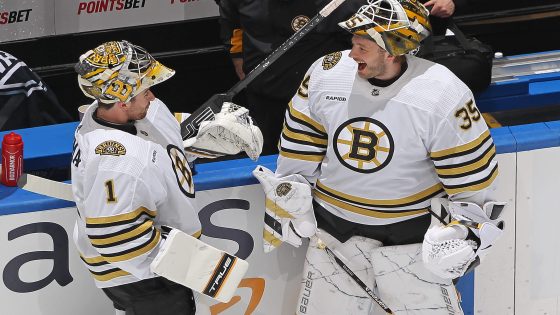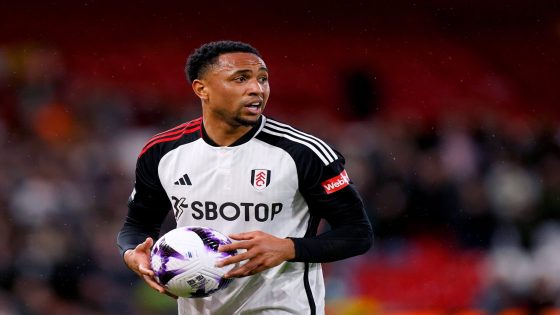The Boston Bruins rotating goalies between games is nothing out of the ordinary — in the regular season.
Jeremey Swayman and Linus Ullmark shared the net all season long in Boston in an almost perfectly even rotation. Swayman started about 52 percent of the Bruins’ games, while Ullmark picked up 48 percent.
But the playoffs aren’t the regular season, so a goalie swap this early — even if that was the status quo for 82 games — raises questions.
Bruins going against grain with goalie rotation
There are true No. 1, bonafide starters in the NHL — Connor Hellebuyck, Andrei Vasilevskiy, Igor Shesterkin, Juuse Saros and Thatcher Demko are prime examples. But a lot of teams have trended toward a more intentional shared approach in recent years, whether a clear 1A/1B distinction or a perfect balance.
But once the playoffs roll around, there tends to be one starter no matter how much the team rotated in the regular season.
Just look at last year’s postseason: 10 of 16 teams saw their “No. 1” play less than 60 percent of the 82 regular season starts. And for the most part, those teams stuck with one goalie for the majority of the playoffs. The Minnesota Wild were a bit of an outlier when they shifted from Filip Gustavsson to Marc-Andre Fleury in Game 2 of the first round, and it burned them. Injuries were behind the Vegas Golden Knights’ “starter” swap. The Devils were forced to make changes in goal when Vitek Vanecek struggled.

But generally speaking, no matter how a team may share starts in the regular season, the playoffs are a different animal.
That’s what makes the Bruins’ switch so bold — especially after Swayman saved 1.54 goals above expected in Game 1.
Maybe there is merit to the idea of keeping Ullmark fresh. Swayman has struggled through consecutive starts in the past, and Boston likely wants to avoid waiting too long to switch like last postseason, when they waited until Game 7 to start Swayman over Ullmark. The big question is how Boston’s coaches handle their net from here, and if any other team follows their lead.
Boston’s not the only team to make a change so far — the New York Islanders did before Game 3. Not everyone has a Vezina-caliber option like Ilya Sorokin at the ready to take over in net, but desperate times — like an 0-2 start — are usually a reason why teams make these playoff switches in the first place. Unlike the Bruins, the Islanders had a true No. 1 this season with Sorokin starting 67 percent of the games. If anything, their case is a bit more similar to the Florida Panthers rolling with their hot hand into the playoffs before going back to their starter in a desperate situation.

Marchand’s Game 3 performance was ‘an art’
Game 3 was a quintessential Brad Marchand playoff performance between his two-way play and rat king antics.
The Toronto Maple Leafs rightfully stuck with the Auston Matthews-Marchand matchup from the first two games in Boston, considering the edge the Leafs gained in that time. In 17 minutes, 28 seconds of head-to-head five-on-five, Toronto had the advantage in shot attempts (18 to 17), scoring chances (11 to 4), and expected goals share (58 percent). It just didn’t work out as well back on home ice.
With Marchand up against Matthews in Game 3, Boston outshot the Leafs 14-3 in less than six minutes, with a 6-1 edge in scoring chances. The Bruins earned 97 percent of the expected goal share and outscored Toronto 1-0 (with a goal courtesy of Marchand). All the while, he leaned into his usual heel role and got some of the Leafs off their game.
Sheldon Keefe is right — what Marchand does is an art, and he is elite at it. That’s what Toronto has to play through to even the series.
Nashville’s extreme defensive shell isn’t the norm
Eighty-four shot attempts and 30 blocks later, the Nashville Predators tied up the series with a 4-1 Game 2 win. The ice was heavily tilted towards the Vancouver Canucks, who attempted 48 more shots than Nashville but converted only one of those chances. The third period was especially slanted. The Canucks generated 37 shot attempts at five-on-five, but ultimately only six went on goal. The Predators, on the other hand, mustered just five attempts of their own.
Shot blocks and excellent goaltending may have been the key to Nashville’s success in Game 2, but it’s not the sustainable way to win. But that isn’t how the Predators generally defend a lead anyway. Usually, they’re a much better, proactive team on both ends of the ice. So that’s what Vancouver has to anticipate moving forward, which puts pressure to avoid some of the mistakes that bit it in Game 2 — from passing on key scoring opportunities and trying to overcompensate for Demko’s absence.
There’s a new second pair in New York
Since K’Andre Miller made the jump to the NHL, he has almost exclusively played with Jacob Trouba. The New York Rangers defensive pair got off to a hot start to open the season but stagnated after the first month of play. It wasn’t until Trouba returned from injury late in the year that the coaches split these two up — moving Braden Schneider up to Miller’s pair and Trouba to play with Erik Gustafsson.
It may not be the most groundbreaking adjustment, but it has solidified the Rangers’ blue line. Now there are two pairs ready for matchup minutes, and a third that is more fitting for sheltered minutes. Game 2 was a prime example of what the Miller-Schneider duo is capable of. In about 14 minutes of five-on-five play, the Rangers generated 15 shot attempts and limited Washington to eight, while earning about 74 percent of the expected goals share. The bump up to the second pair has helped stabilize Miller’s game and allowed Schneider’s shutdown ability to shine.
Hellebuyck’s surprising 10 goals against
As chaotic and fun as Game 1 between the Colorado Avalanche and Winnipeg Jets was, high-scoring games like that probably shouldn’t be expected in this series — not when Connor Hellebuyck is in net. He saved 39.5 more goals than expected in the regular season, which led the league and is the seventh-best mark in the analytics era (2007-08 to present).
That’s what makes the Jets’ start so surprising. Through two games, Hellebuyck has allowed 10 goals, which is about 1.50 more than expected based on his workload.
To Hellebuyck’s credit, the Avalanche put the pressure on in Game 2. Their 49 unblocked shots added up to 4.30 expected goals for. So Hellebuyck’s four goals against was pretty average relative to the shot quality he faced.
But he isn’t a goaltender who is expected to be average. Hellebuyck is the Jets’ backbone and is leaned on to be the difference on a nightly basis. It’s too early to sound any alarms about his game just yet, but he isn’t the goalie most of us anticipated talking about after two games of this series.
Byfield-Kopitar-Kempe help even the series
Quinton Byfield moved back up to the top line with Anze Kopitar and Adrian Kempe to help fuel the Los Angeles Kings’ Game 2 win. In about 10 minutes of five-on-five play, the Kings had an advantage in shots (15-7), expected goals (75.7 percent), and goals (3-0) over the Edmonton Oilers. Kempe converted twice on his nine shot attempts, and Byfield helped facilitate plays. Kopitar, on the other hand, showed why he’s in the Selke conversation this year — especially against Leon Draisaitl’s line.
Kopitar and Draisaitl went head-to-head for 6:19 on Wednesday night, and the Kings center helped limit Edmonton to just two shot attempts while generating 10 of their own. Los Angeles challenged the Oilers’ defense with quality chances and outscored them 2-0.
With the series shifting back to home ice for the Kings, it’ll be interesting to see if the coaches stick to that matchup or see if Kopitar can try to slow Connor McDavid down.
Vegas disrupting Stars in Round 1
It may not seem like it, down 0-2 on home ice, but the Dallas Stars are playing well so far to open the playoffs. At five-on-five, they’re generating more shots and quality chances than Vegas. And Dallas goaltender Jake Oettinger played a much stronger Game 2.
But Vegas is just making the most of its opportunities to jump out to the early series lead. The Golden Knights’ forecheck is a standout so far, which is disrupting the Stars’ ability to move the puck up the ice. And when the Stars do have possession, Vegas skaters are getting sticks in the way to take away their chances — Chandler Stephenson and Alec Martinez stopping Dallas from pulling even late in the third in Game 2, for example.
Dallas attempted 26 all-situation shots in the third period on Wednesday night — the same as the Golden Knights. But only five went on net, thanks to Vegas’ shot blocking and positioning to force the Stars to miss the net.
Home ice frees up Bo Horvat line
With home-ice advantage in Games 1 and 2, the Carolina Hurricanes opted for a power-versus-power matchup for their top line. Instead of matching the New York Islanders’ Bo Horvat, Mathew Barzal and Casey Cizikas with Jordan Staal’s line, the Hurricanes sent out Jake Guentzel, Sebastian Aho and Andrei Svechnikov.
In almost seven five-on-five minutes of Horvat versus Aho in Game 1, Carolina tilted the ice with eight shot attempts to the Islanders’ three and 82 percent of the expected goal share. The Hurricanes swarmed that line even more in Game 2. In 10:22 of matchup time, the Canes outshot the Islanders 20-4 with an almost-89 percent expected goals rate.
Getting away from that matchup primary in Game 3, back on Long Island, helped free up the Horvat line a bit more. Horvat still saw Aho for 3:42 but also spent 5:31 against Staal. The Islanders’ top line was above break-even in shots and expected goals for the first time this series. That could give the Islanders a small opening to extend this series if they can find a way to capitalize on it before going back to Raleigh.
Tampa Bay defensive depth exposed
At least the Lightning had playoff Vasilevskiy in Games 1 and 2 to help mask just how imbalanced this series is. He saved four goals above expected on the road before a subpar game back on home ice.
Without Vasilevskiy doing everything he can to push his team forward, the Lightning’s lack of depth on the blue line is glaring. The top pair of Victor Herman and Darren Raddysh has been fine so far. Everyone behind them has struggled at one point or another in this series.
The Panthers are driving right to the quality areas in Erik Cernak’s minutes, with 26 scoring chances to the Lightning’s 16 at five-on-five. Matt Dumba’s last two outings have been rough, and mistakes in Game 3 contributed to Florida outscoring the Lighting 2-1. Emil Lilleberg looks out of his depth, and defenders who have rotated in — like Maxwell Crozier and Calvin de Haan — have struggled in limited minutes.
The Lightning were bound to be outmatched by the Panthers. But Tampa Bay’s defense could be what gets them eliminated sooner rather than later.
— Data via Evolving-Hockey, HockeyViz, HockeyStatCards, AllThreeZones, and NaturalStatTrick. This story relies on shot-based metrics; here is a primer on these numbers.
(Photo of Jeremy Swayman, left, and Linus Ullmark: Claus Andersen / Getty Images)



